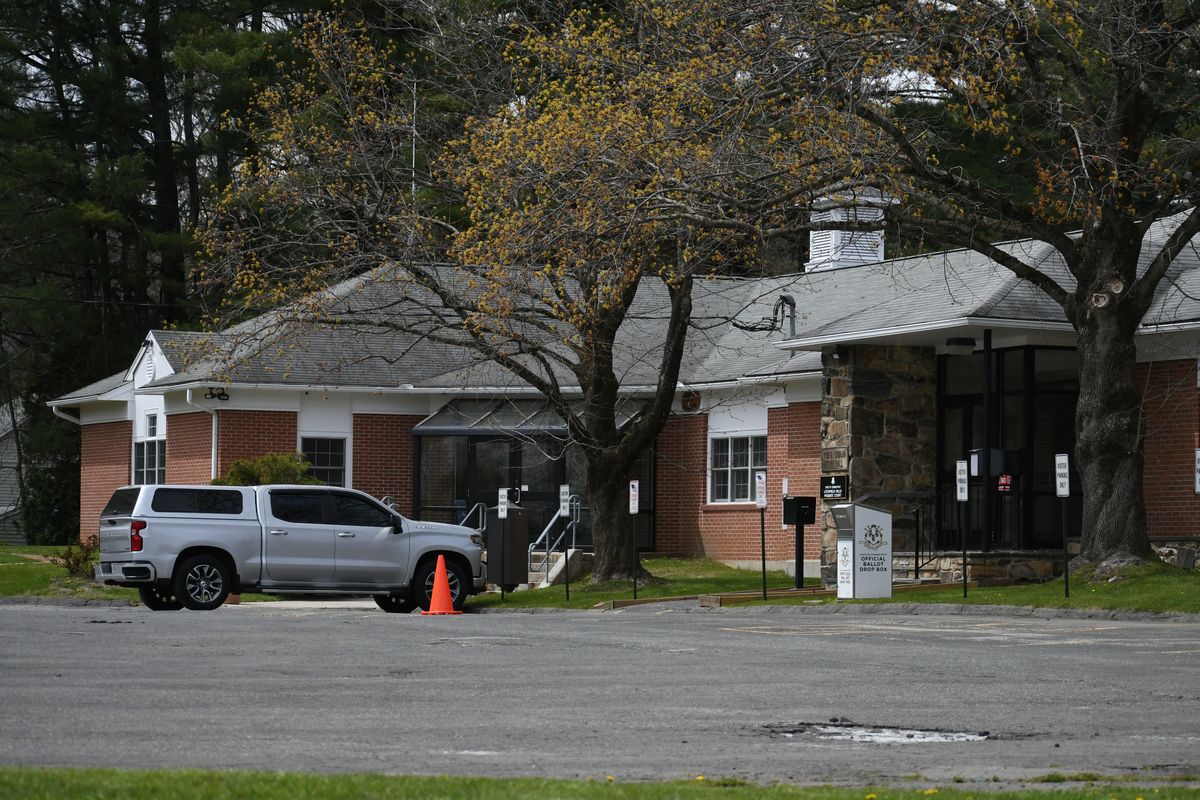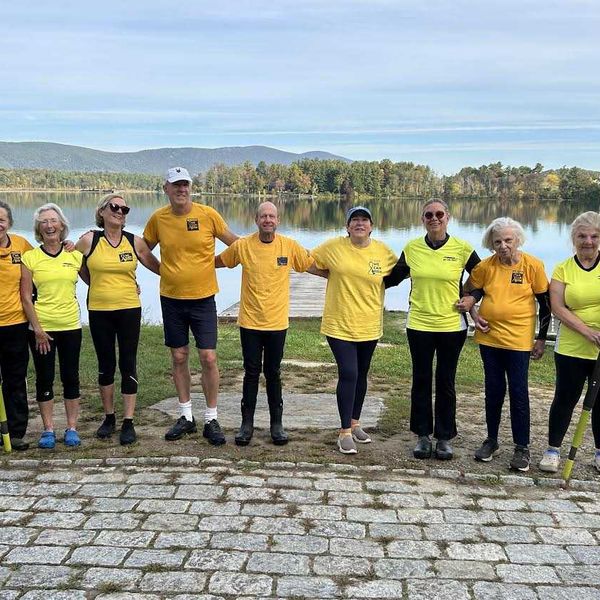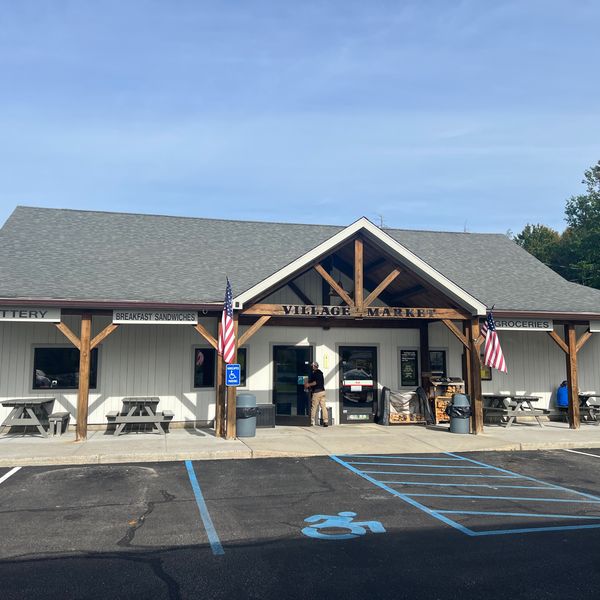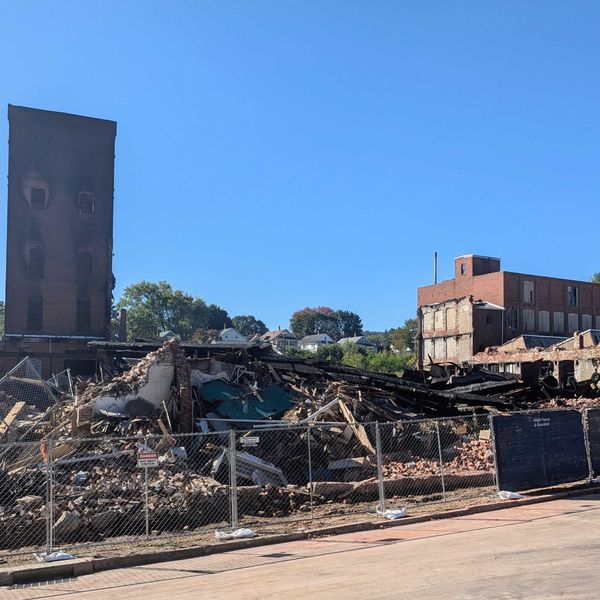Latest News
Housatonic Valley FFA students prepare for the upcoming convention with teacher David Moran.
Kellie Eisermann
FALLS VILLAGE — Housatonic Valley FFA students are gearing up to head to the 98th annual National Convention in Indianapolis, Indiana, Oct. 29 to Nov. 1.
This year, students are preparing to take on the landscape, horse judging, creed speaking and extemporaneous competitions.
Creed speaking involves memorizing and reciting all five paragraphs of the FFA Creed (by E.M. Tiffany).
Contestants are judged on how well and uniquely the creed is presented, and the judges question the speaker on aspects of the creed.
For extemporaneous speaking, the student is given a topic relating to agriculture and has 30 minutes to prepare before answering questions from the judges.
Riley Mahaffey will be taking on her third year of public speaking at the national level.
The landscape team consists of Madeline Collingwood, Michael Gawel, Hayden Bell and Byron Bell. The competition will include plant identification, a written exam, landscape practicums and a team event.
The equine judging team consists of Madison Melino, Darwin Wolfe, Hannah Johnson and Kellie Eisermann. The competitions will include a general knowledge test, judging horses in halter classes and under saddle, oral questions and a team event to wrap it all up.
Zayre Trail is advancing to the national level to represent the Housatonic Valley FFA chapter as the creed speaker.
Kellie Eisermann is the FFA Reporter this year She is a junior and lives in Lakeville and plans to go into the family business, Four Seasons Pool Service in Millerton.
Keep ReadingShow less
Democratic Town Committee chair Chris Jacques added public comment at the Board of Selectmen meeting Monday, Oct. 6. From left, Jacques, First Selectman Brian Ohler, Selectman Craig Whiting and Selectman Jesse Bunce.
Screenshot from Zoom
NORTH CANAAN — At the Oct. 6 meeting of the Board of Selectmen, speakers had to use a microphone sound system so those in the back of the audience could hear them as residents filled the meeting room for the last selectmen’s meeting before the Nov. 4 election.
In the month leading up to the October meeting, state troopers were called to Town Hall to remove Town Clerk Jean Jacquier, whose return to work after nearly eight months of absence followed a judge’s decision to upholdher removal from the ballot as a candidate.
Democratic Town Committee (DTC) chair Chris Jacques spoke during the public comment period at the start of the meeting.
He said that First Selectman Brian Ohler deliberately waited until after the Aug. 6 deadline for nominating petitions to be filed to alert the Secretary of the State’s(SOTS) office about the faulty DTC paperwork and that the Republican candidate for town clerk, Krystian Segalla, had used a nominating petition because of a similar error on the Republican Town Committee’s part.
He said the Republicans were notified but the Democrats were not.
“When standard procedures for correcting errors are selectively applied there are serious questions about fairness in our electoral processes.”
Ohler then spoke for about 40 minutes about the controversies surrounding Jacquier and provided his timeline of events.
“This has been a long two years, I won’t sugarcoat it,” he said.
He said complaints about Jacquier’s conduct as town clerk go back to the previous administration and that he received at least six complaints early in his term.
He said he had no choice but to act on the complaints.
Ohler responded to charges that he or Paul Mattingly, who is the selectmen’s executive assistant and filling in as assistant town clerk, had manipulated Town Hall security video footage that was the subject of a Freedom of Information Act request from the DTC.
Ohler said the reason there are gaps in the footage is that the video system uses a motion sensor, which does not provide continuous footage.
“So yes, there are long periods with no recording.”
He said allegations that the footage was altered are baseless. “We don’t have the capability.”
Ohler said that he and Cheryl Duntz did examine the DTC endorsement form (missing the information for Jacquier and Overby) shortly before 4 p.m. on July 23.
He said he did not have advance notice of the errors on the DTC form but did see the paperwork. “I went in on deadline day and took a photo.”
Ohler said candidates and party officials usually look at the candidate filings so they know who they are running against. “That’s how I found out you were running for First Selectman,” he said to Selectman Jesse Bunce.
Ohler said the Republicans were not notified of the missing signatures on the endorsement slates for candidates Krysti Segalla and Tucker Whiting. He told The Lakeville Journal that RTC secretary Cheryl Duntz noticed the missing signatures while double checking the forms on July 30. She then asked for advice from the SOTS office and learned the candidates could petition to remain on the ballot if enough signatures were attained and filed by Aug. 6.
As far as querying the SOTS office on Aug. 7 about missing information on the DTC slate, Ohler said he was within his rights as first selectman to do so.
Ohler said that in early February 2025 he assumed Jacquier had left her position. He said one person had asked her about an absentee ballot and Jacquier replied that she had received it but was no longer Town Clerk. He showed an email sent from Jacquier to the Adkins Printing Company on Feb. 7 instructing them not to send grant materials because she had left the job.
When asked about the email to Adkins, Jacquier confirmed she sent it and stated “there was a good reason for it. I knew I was not in the office for a time. There are reports that have to be filed on certain dates for that grant also, the grant has to be done by a certain date or the money has to be returned, and I did not want to take responsibility for that. And of course my assistant had never really done it on her own before so I was being very safe and saying, I just don’t want that responsibility since I’m not there.”
Ohler said he made contact with Jacquier’s husband who said she was finished with the job.
“So what would you assume?” Ohler asked the audience at Town Hall.
Moving on, Ohler said the State Elections Enforcement Commission (SEEC) was investigating Jacquier as of July 10 for soliciting for candidates in Town Hall, untimely stamping of documents and failure to fine candidates forlate campaign filings.
The Lakeville Journal has confirmed the SEEC investigation is ongoing.
Ohler said Jacquier came to Town Hall on Aug. 14 at 7:45 a.m. and found the locks had been changed, which Ohler said was done back in March.
Ohler described Jacquier as “enraged” and said she “proceeded to tear down all the signs” on the door of the town clerk’s office.
The state police were called. Ohler said Jacquier was ordered to leave and did so. He said he had to restrict Jacquier’s access to Town Hall until her intent could be determined, and that if Jacquier wanted to return to work she must have her legal team get in touch with the town’s lawyers to make that happen.
“To date this has not happened.”
Jacquier provided copies of emails to The Lakeville Journal that were sent by her attorneys to North Canaan town counsel Randy DiBella. On March 11 attorney Jeffrey Mirman wrote “Ms. Jacquier has not abandoned her office” and intends to return to work when she feels ready. On Aug. 14 attorney John Kennelly wrote Jacquier did not resign and cannot be locked out of the office. He requested a set of working keys be provided to Jacquier.
Ohler said Jacquier returned to Town Hall at 8:30 a.m. on Monday, Sept. 29, sat down at a computer and asked for a copy of the current key.
Jacquier told The Lakeville Journal she went to help prepare for the election.
The state police were called again, and again Jacquier left.
Ohler said he has an obligation to maintain the security of Town Hall, and particularly the Town Clerk’s office and the documents and records therein.
He noted that Jacquier is still technically the town clerk. “I did not remove her,” he said. “We’re restricting access until we know her intent.”
Keep ReadingShow less
North Canaan Town Hall.
Photo by Riley Klein
NORTH CANAAN — The following is a timeline of events involving the North Canaan Town Clerk, Jean Jacquier. This timeline relies on public records and previous Lakeville Journal reporting.
November 2023: Brian Ohler (R) is elected First Selectman. Jacquier (R) is elected to her fourth term as Town Clerk.
January 2024: Ohler filed a complaint with state Attorney General alleging misconduct by Jacquier, including improper security of the vault, posting candidate campaign material in Town Hall and untimely stamping of documents.
August 2024: Jacquier filed a lawsuit against the Town of North Canaan seeking reimbursement for legal fees. The case is still pending.
Oct. 9, 2024: The Attorney General’s office released the results of its investigation, which “found evidence of misconduct and neglect of duty in three areas: (1) improper security of the vault outside of the Town Clerk’s hours of operation; (2) improper posting of campaign materials in Town Hall; and (3) untimely stamping of documents received by the Town Clerk’s office.”
No further action was taken by the AG’s office. The letter “strongly recommend” Jacquier implement changes to her practices and review standards governing vault security, political activity by municipal officials, and stamping or endorsing documents.
Feb. 3, 2025: Jacquier walked out of the Town Clerk’s office, “stating that she could not stand the turmoil and had conflicts with the first selectman and the clerk in the office of the building official. This has left [Marilisa] Camardi, the part-time assistant town clerk, to serve as acting town clerk, in charge of the town clerk’s office” (from Torrington Superior Court’s Sept. 24, 2025, decision in a subsequent lawsuit filed by Jacquier against Assistant Town Clerk Marilisa Camardi).
March 12: The Board of Selectmen vote to suspend Jacquier’s pay until she returns to work. Ohler and Selectman Craig Whiting (R) voted to suspend, Selectman Jesse Bunce (D) abstained (Bunce is a registered Republican endorsed by the Democrats to run against Ohler for First Selectman).
July 22: The North Canaan Democratic Town Committee (DTC) held its caucus and voted for a slate of candidates for the municipal election of Nov. 4, 2025. The candidates included Jacquier for town clerk and Carol Overby for the Board of Finance.
There is a form to be filled out and submitted to the Town Clerk’s office. On this form candidates supply their name, address, the office they are running for and the term, and a signature.
Overby, who was at the caucus, did not include that she was running for the finance board on the form.
July 23: North Canaan DTC chair Chris Jacques met with Jacquier, who was not at the caucus, to fill out the form. Jacquier also did not include the office she was running for. “Jacquier admits this was a mistake” (from the Sept. 24 decision).
The filing deadline was July 23, 4 p.m. At 3:34 p.m. Jacques filed the DTC endorsement form with Camardi, the assistant town clerk, who accepted it and stamped it as received.
From the decision: “This was Camardi’s first experience with municipal elections as she had worked in the office for only one and one-half years. Likewise, this was the first time Jacques had submitted a certification of party endorsement form.
“Shortly thereafter on July 23, 2025, the first selectman and Cheryl Duntz, a member of the Republican Town Committee, asked to see the [Democratic Town] Committee’s certification of party endorsement form. They reviewed the form and then left. Camardi left at 4 p.m. on July 23, 2025.”
July 24: Camardi, while preparing the legal notice of the candidates for the Waterbury Republican-American, noticed the omissions by Jacquier and Overby. Along with the certification of party endorsement forms, town committee chairs also file two forms with the Connecticut State Elections Enforcement Commission. The missing information was on the SEEC Form 1, so Camardi edited the endorsement form to add “Town Clerk” to Jacquier’s information and “Board of Finance” to Overby’s.
Aug. 6: This was the deadline to gather signatures to petition to fill a party endorsement vacancy, which existed for the Democratic slate for Town Clerk and Board of Finance because of the faulty paperwork.
Aug. 7: Ohler emailed Heather Augeri at the Secretary of the State’s (SOTS) office and attached the DTC endorsement form as it was submitted before Camardi added the words “Town Clerk” and “Board of Finance” to the form. Ohler asked Augeri if the form was valid and Augeri responded it was not and Jacquier and Overby could not be on the November ballot.
Sept. 5: Jacquier and Overby filed a lawsuit against Camardi, the acting Town Clerk, and requested an accelerated court schedule because the election was coming up.
The case was tried Sept. 12, with Jacques, Jacquier and Camardi testifying. There were additional appearances in court on Sept. 15 and 16. On Sept. 16 both parties rested their cases.
Sept. 23: Camardi submitted her letter of resignation from the role of Assistant Town Clerk.
Sept. 24 Judge Ann E. Lynch of the Superior Court, Litchfield District ruled against Jacquier and Overby, stating, “The plaintiffs did not substantially comply with Connecticut General Statute 9-391 by filling out forms that pertain to completely different statutory requirements relating to campaign financing.
“This court cannot ignore the mandatory requirements of §9-391. Accordingly, this court finds that Camardi properly determined that Jacquier and Overby’s names cannot appear on the ballot for the November 2025 election.”
Sept. 29: Jacquier comes to Town Hall and is ordered to leave by state police.
For what followed, see accompanying coverage of the Oct. 6 Board of Selectmen meeting.
Keep ReadingShow less
Come to the Cornwall Fire open house
Everyone is invited to the Cornwall Volunteer Fire Department’s OPEN HOUSE from 12 noon until 2 p.m. on Sunday October 19th.
This festive event will take place at the Fire House (289 Sharon Goshen Turnpike, West Cornwall). There will be a “Kids Zone” of games and activities, equipment and safety information, tour of the fire house and a chance to meet your fire and ambulance volunteers. Other highlights include a visit from the LIFESTAR helicopter (weather permitting) and lunch provided by The Cornwall Association. CVFD’s New Fire Trucks Campaign will be explained. You’ll see examples of the two new trucks CVFD is hoping to purchase courtesy of the Sharon and Falls Village volunteer fire departments. All ages are welcome to this free event.
Dick Sears
CVFD President
Cornwall
Gratitude to 21st Century Fund for athletic grant
I would like to express my sincere gratitude to the 21st Century Fund for Housatonic Valley Regional High School for awarding me a Region 1 Athletic Fund grant. This grant made it possible for me to participate in the summer rowing session at Litchfield Hills Rowing Club. One of the highlights of my season was the Philadelphia Youth Regatta in July, where both my U17 Mixed Double and U17 Women’s Quad placed first, earning two gold metals. I also competed in the Women’s Varsity Squad, a boat composed entirely of freshmen racing against athletes heading into college, and finished with a second-place result. This challenge pushed me to race with determination and confidence.
The Fund’s continued support of HVRHS student athletes makes a meaningful difference by encouraging us to pursue our goals beyond the classroom and to stay connected to our community.
I’m truly honored to have been selected as a recipient, and I want to thank the board members and all who contribute to the Fund for investing in the future of local students.
Thank you again for the Fund’s support and commitment to Housatonic students.
Alison McCarron
Kent
Vote for Kiefer
I’m writing to support Kitty Keifer for Selectman in Salisbury.Kitty is currently in that role and I propose we re-elect her.
Kitty is very effective and hard working.She is authentic, open, focused on the town.
We are lucky to have her as a public servant.
VOTE FOR KITTY KIEFER!
Janet André Block
Salisbury
The people want democracy, not dictatorship …
Dear Mr. President,
The people want:
Their democracy, not your dictatorship;
George Washington on the commemorative coin for the 250th anniversary, not you;
A President of all fifty states and all Americans, not just red states and maga republicans;
Funded and trained local police, not Federal troops in training on the streets;
Deportation of convicted criminals, not squads of ICE goons running amok;
Prosecution for actual current crimes, not retribution for past political disagreement;
Compromise, not partisan victory or defeat;
Decency, sympathy, compassion and empathy, not raw meanness and sadism;
Health care for all, not tax breaks for the rich;
Prompt government reports, not poor excuses;
A military loyal to the Constitution, not to you;
Clean and funny humor, not distasteful bigotry and misogyny;
Qualified and independent government officials, not intimidated disciples;
Consistent basic honesty, not a series of lies;
A Commander in Chief as fit as his generals and admirals, not an overweight goofer;
Deescalation, not provocation;
Soldiers who serve with honor, not crafty draft dodgers;
Free and independent judges, lawyers, universities, and journalists, not your puppets;
A sound United States Dollar, not speculative crypto currency;
Fair trade, not tariff yoyo;
Public health policy based on science, not whimsy;
A government at work, not off;
Loyalty to our allies, not disregard of our international obligations;
Disbursement of appropriated funds, not impoundment, and above all;
Understanding and adhering to the Constitution and the rule of law, not ignorance and disregard.
G. A. Mudge
Sharon
Community goes above
Let me tell you what a great town we live in. During the first day of the Fall Festival I was volunteering at the Friends of the Library book sale. After my shift was over I went to Herrington’s to pick up a few things. Then to Lakeville Wine and Spirits for some wine and spirits, and then to LaBonne’s. Somewhere during my travels I lost my wedding ring which represented forty years of happiness. Needless to say I was upset and contacted the various locations to ask them to search for this very important symbol of my life. My wife and I retraced my footsteps. Nothing at the library. Nothing at Herrington’s. Nothing at Lakeville Wine, but LaBonne’s had the ring. A young man had found it and brought it to management.
All four organizations had their personnel search for my ring. At Herrington’s, two of the employees went to our car while I was inside searching and consoled my wife. How sweet and thoughtful is that?
That is the kind of town we live in… people who are concerned for others and who will go out of their way to help. I have my ring but I have something even more valuable in the people who share my life day to day. Is there anything better?
Macey Levin
Taconic
‘All politics is local’
It’s as true now as it was when Tip O’Neill was Speaker of the House 40 years ago. To serve their constituents best local candidates should concentrate on local issues. That’s not to say we shouldn’t be concerned about national political issues, but Salisbury Selectmen have to deal with our local problems.
Don Mayland recognizes the important problems we face in the Town of Salisbury. He knows we must have more affordable housing that is compatible with our town’s character and zoning laws. Big city politicians will try again to pass a law to override our local zoning ordinances. We must beat them to it and make our town attractive to the younger people who work in local businesses, join local service organizations and maintain our fire and ambulance services.
Don Mayland has been president of the Lake Wononscopomuc Association. He is keenly aware of the threat that the vicious weed Hydrilla poses to our beautiful lakes. Don has the experience to know what our local issues are and how to deal with them.
Don Mayland served on The Board of Finance of the Town of Salisbury for 24 years. Don has served 3 terms on the Board of Selectmen of the Town of Salisbury. He was Chairman of the Board of Directors of Litchfield Bancorp for 26 years. He has years of service on the Water Pollution Control Authority, the Salisbury Volunteer Ambulance Service, the Northwest Connecticut Community Foundation and the Marketplace of Salisbury.
We need Don Mayland back of the Board of Selectmen to deal with the issues of the Town of Salisbury.
Bill Littauer
Lakeville
Ohler will bring positive changes
With the upcoming election in North Canaan, I would like to voice why I support the re-election of Brian Ohler as First Selectman.
I have known Brian for most of his life and have watched as he served first our nation, then our local area at a state level, to then become the leader of the town he has proudly called home. During the last two years I have watched him tackle budgets, residential grievances, difficult situations, and a host of other items I wouldn’t take on for anything. And he has done it with grace and dignity.He has been empathetic and respectful, supportive and encouraging. So many times, I know I would have thrown in the towel, but he just goes on with that quiet, dignified air. He has (along with others) been able to bring about significant changes to the town of North Canaan. Some changes were in the works when he was first elected, while others were done during this tenure. He has made a difference.
I know change is difficult and the town of North Canaan has gone through a number of changes over the last two years. But change is the essence of life. Roald Dahl wrote “Somewhere inside of all of us is the power to change the world.”Brian has changed our little part of the world, which, although not always fully appreciated, was necessary. I have no doubt that when re-elected he will continue to bring about positive changes to the Town of North Canaan.
Do I stand by Brian Ohler because I have known him for too many years to count? Maybe that is part of it. But more so I support Brian Ohler because he has the knowledge, the grace, the humility and the perseverance to continue to positively shape the Town of North Canaan.
Ayrslea Odell
North Canaan
There are solutions to ‘serious threats’
Full Disclosure: When first in New York City as a young Republican I stuffed envelopes and rang door bells for Nelson Rockefeller and Jacob Javits. On 9/26/2000, I changed my voter registration to “Unaffiliated.”Recently I received a “Dear Friend” letter from the Salisbury Republican Town Committee that highlights “serious threats.” One perceived threat is from “big city politicians” who wish to override our zoning laws and build “welfare housing”, which the letter writers say will affect our property values. Those who study propaganda would have fun with this clearly fallacious scare scenario. But it is not funny when these writers underestimate how important it is for our town to find more affordable housing close to Salisbury businesses. Another stated threat relates to Hydrilla in our lakes and ponds. This is not news. Efforts to eliminate this invasion are underway, and the Republican Town Committee fails to suggest any improved techniques or approaches to this costly problem. The third “threat” is the danger of walking on state roads. Again no solution is offered.Perhaps those walking or running on heavily trafficked state roads could be encouraged to make use of the town’s recreational facilities or walk on less trafficked local roads.
The letter ends by extolling Republican candidates who “are working on these problems” while Democrats are focused on Washington and by implication neglecting matters locally. If these are the big “serious threats” we face, perhaps, like the democrats, the Town Committee should reflect on what is happening in Washington where some perceive existential threats to democracy.
Philip V. Oppenheimer
Lakeville
Salisbury benefits from Democrats
Salisbury continues to be one of the best run towns in CT. The quality of life here is high with excellent town services and schools that attract a wealth of talented, community-minded people. Some step right up to volunteer for the elected and appointed positions that keep the town running smoothly and efficiently with the lowest mil rate in the state. People like Cori Daggett (Zoning Board of Appeals Alternate) and Jen Ventimilia (Planning and Zoning Alternate)
There are fifteen seats open to Democrats this year and the Democratic Town Committee has excellent candidates for each one. At the top of the ticket is Curtis Rand as First Selectman. His leadership has seen the town through many challenges and improvements. We look forward to another two years of the same as he continues working on solid waste, modernizing and maintaining infrastructure, supporting the various groups that are building affordable housing, protecting our natural environment, and taking care of citizens of all ages.
For Second Selectman we have Barrett Prinz. He has served for nine-years on Salisbury Central Board of Education and is an active member of the Salisbury Volunteer Ambulance Squad. Barrett also serves on the board of Salisbury Family Services. He’s an accomplished attorney with experience in private practice but more recently with international Non-Governmental Organizations helping smallholder farmers across East Africa and helping US and foreign governments strengthen their public health systems. I’m not making this up!
A newcomer to elected office but not to Salisbury and community service, we have first-time candidate Lauren Brown for Board of Education. She currently serves as the Executive Director of the SOAR program following seven years of teaching third grade at Indian Mountain School. Lauren is also an active volunteer with Project Sage.
Space is limited here so look for the rest of our slate in ads here in The Lakeville Journal and from soon-to-be-sent mailers. If you cannot wait to see who these hard working incumbents are, go to our website at salisburydemocrats.com.
See you on Nov. 4.
Al Ginouves
Chairman, Salisbury DTC
Salisbury
Keep ReadingShow less
loading












